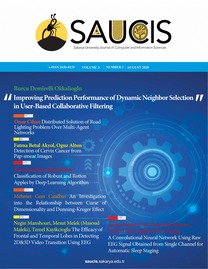EOG İşaretini Kaynak İşaret Olarak Kullanmak Üzere Etkin Özelliklerin Belirlenmesi
Determining Effective Features to Use the EOG Sign as a Source Sign
___
[1] T. Öztürk, “Hawking’in Konuşma Cihazı ve P300 - Toprak Öztürk - Medium,” 2018. [Online]. Available: https://medium.com/@toprakozt/hawkingin-konuşma-cihazı-vep300- b38f938733dd. [Accessed: 13-Dec-2019].[2] Tobii, “Tobii Eye Tracker 4C for PC Gaming. Buy Now at €169 - Tobii Gaming,” 2019. [Online]. Available: https://gaming.tobii.com/tobii-eye-tracker-4c/. [Accessed: 13-Dec- 2019].
[3] J.-S. Lin and W.-C. Yang, “Wireless brain-computer interface for electric wheelchairs with EEG and eye-blinking signals,” Int J Innov Comput Inf Control, vol. 8, pp. 6011– 6024, Sep. 2012.
[4] A. B. Usakli and S. Gurkan, “Design of a novel efficient humancomputer interface: An electrooculagram based virtual keyboard,” IEEE Trans. Instrum. Meas., vol. 59, no. 8, pp. 2099–2108, Aug. 2010.
[5] M. Y. Esas and F. Latifoglu, “Computer-Based design with dual channel device electrooculography and eye movement tracking,” in 2015 Medical Technologies National Conference (TIPTEKNO), 2015, pp. 1–4.
[6] J. Heo, H. Yoon, and K. Park, “A Novel Wearable Forehead EOG Measurement System for Human Computer Interfaces,” Sensors, vol. 17, no. 7, p. 1485, Jun. 2017.
[7] S. Gül, Z. Tiryaki, E. Kuzu, M. Milligüney, and G. Çetinel, “Move Your Wheelchair with Your Eyes,” Int. J. Appl. Math. Electron. Comput., vol. 1, no. SpecialIssue, pp. 5– 8, Aug. 2017.
[8] H. Ö. Ülkütaş, “Eog’nin Kodlanmasina Dayanan Bilgisayar Tabanli Gözle Yazi Yazma Sistemi Geliştirilmesi,” Başkent Üniversitesi, 2015.
[9] M. K. Uçar, K. Polat, M. R. Bozkurt, and C. Bilgin, “Effect of Tıme and Frequency Domaın Features ın Sleep Eeg and Eog Sıgnals Classıfıcatıon,” in Tıp Teknolojileri ulusal Kongresi, 2014, vol. 1, pp. 0–5.
[10] G. Gündüz and İ. H. Cedimoğlu, “Derin Öğrenme Algoritmalarını Kullanarak Görüntüden Cinsiyet Tahmini,” Sak. Univ. J. Comput. Inf. Sci., vol. 2, no. 1, pp. 9–17, Apr. 2019.
[11] K. Serbest, M. R. Bozkurt, and O. Eldoğan, “Classification of cardiac arrhythmias with artificial neural networks according to gender differences,” J. Eng. Sci. Technol., vol. 10, no. 9, pp. 1144–1149, 2015.
[12] G. D. Çetin, Ö. Çetin, and M. R. Bozkurt, “The Detectionof Normal and Epileptic EEG Signals using ANN Methods with Matlab-based GUI,” Int. J. Comput. Appl., vol. 114, no. 12, pp. 45–50, 2015.
[13] M. R. Bozkurt, A. Subaşı, E. Köklükaya, and M. Yilmaz, “Comparison of AR parametric methods with subspace-based methods for EMG signal classification using stand-alone and merged neural network models,” Turkish J. Electr. Eng. Comput. Sci., vol. 24, no. 3, pp. 1547–1559, 2016.
[14] M. R. Bozkurt, M. K. Uçar, F. Bozkurt, and C. Bilgin, “In obstructive sleep apnea patients, automatic determination of respiratory arrests by photoplethysmography signal and heart rate variability,” Australas. Phys. Eng. Sci. Med., pp. 1–21, 2019.
[15] M. K. Uçar, M. R. Bozkurt, K. Polat, and C. Bilgin, “Investigation of effects of time domain features of the photoplethysmography (PPG) signal on sleep respiratory arrests,” in 2015 23nd Signal Processing and Communications Applications Conference (SIU), 2015, pp. 124–127.
[16] K. Polat and S. Güneş, “A new feature selection method on classification of medical datasets: Kernel F-score feature selection,” Expert Syst. Appl., vol. 36, no. 7, pp. 10367– 10373, Sep. 2009.
[17] A. R. Kavsaoğlu, K. Polat, and M. R. Bozkurt, “An innovative peak detection algorithm for photoplethysmography signals: an adaptive segmentation method,” Turkish J. Electr. Eng. Comput. Sci., vol. 24, no. 3, pp. 1782–1796, 2016.
[18] V. Gerla et al., “Automatic identification of artifacts and unwanted physiologic signals in EEG and EOG during wakefulness,” Biomed. Signal Process. Control, vol. 31, pp. 381–390, 2017.
[19] J. G. Colonna, M. Cristo, M. Salvatierra, and E. F. Nakamura, “An incremental technique for real-time bioacoustic signal segmentation,” Expert Syst. Appl., vol. 42, no. 21, pp. 7367–7374, Nov. 2015.
[20] N. A. B. Baharom, “Analysıs of Electrooculography (Eog) for Controllıng Wheelchaır Motion.” 2015.
[21] M. K. Uçar, “Eta Correlation Coefficient Based Feature Selection Algorithm for Machine Learning: E-Score Feature Selection Algorithm,” Zeki Sist. Teor. ve Uygulamaları Derg., vol. 2, no. 1, pp. 7–12, 2019.
[22] E. Şahin, “Makine Öğrenme Yöntemleri ve Kelime Kümesi Tekniği ile İstenmeyen e- Postasınıflandırması,” Hacettepe Üniversitesi, 2018.
[23] J. B. Ahire, “The Artificial Neural Networks Handbook: Part 4,” 2018. [Online]. Available: https://medium.com/@jayeshbahire/the-artificial-neural-networkshandbook- part-4-d2087d1f583e. [Accessed: 17-Nov-2019].
[24] M. Tosun, M. Erginli, Ö. Kasım, B. Uğraş, Ş. Tanrıverdi, and T. Kavak, “EEG Verileri Kullanılarak Fiziksel El Hareketleri ve Bu Hareketlerin Hayalinin Yapay Sinir Ağları İle Sınıflandırılması,” Sak. Univ. J. Comput. Inf. Sci., vol. 1, no. 2, pp. 1–9, Aug. 2018.
[25] C. Beleites, R. Salzer, and V. Sergo, “Validation of Soft Classification Models using Partial Class Memberships: An Extended Concept of Sensitivity & Co. applied to the Grading of Astrocytoma Tissues,” Jan. 2013.
[26] M. Gök, “Makine Öğrenmesi Yöntemleri ile Akademik Başarının Tahmin Edilmesi,” Gazi Üniversitesi Fen Bilim. Derg. Part C Tasarım ve Teknol., vol. 5, no. 3, pp. 139– 148, Sep. 2017.
[27] A. Dirican, “Tani Testi Performanslarinin Değerlendirilmesi Ve Kiyaslanmasi,” Cerrahpaşa Tıp Derg., vol. 32, no. 1, 2001.
[28] L. H. Geyer and C. G. DeWald, “Feature lists and confusion matrices,” Percept. Psychophys., vol. 14, no. 3, pp. 471–482, Oct. 1973.
- ISSN: 2636-8129
- Yayın Aralığı: Yılda 3 Sayı
- Başlangıç: 2018
Design Tradeoffs in Full Electric, Hybrid and Full Chemical Propulsion Communication Satellite
Hafif Sıklet Şifreleme Algoritmalarının Performans Karşılaştırması
Ünal ÇAVUŞOĞLU, Hussein AL SANABANI
İbrahim CIL, Sümeyye Gizem ÇAKAR, Nazan SARI, Olcay EYDEMİR
An Analysis of the Characteristics of Verified Twitter Users
Abdullah Talha KABAKUS, MEHMET ŞİMŞEK
EOG İşaretini Kaynak İşaret Olarak Kullanmak Üzere Etkin Özelliklerin Belirlenmesi
